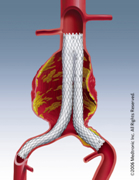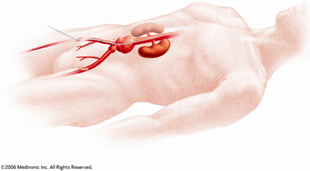VASCULAR CENTER
Vascular & Endovascular Surgery
Abdominal Aortic Aneurysm (AAA)
 The aorta is the largest artery in the body. The part of the aorta that carries blood from your heart through your abdomen, and splits into iliac arteries that supply your legs, is called the abdominal aorta. Smaller arteries also branch off the aorta at several points to carry blood to various organs and other parts of the body.
The aorta is the largest artery in the body. The part of the aorta that carries blood from your heart through your abdomen, and splits into iliac arteries that supply your legs, is called the abdominal aorta. Smaller arteries also branch off the aorta at several points to carry blood to various organs and other parts of the body.
An aneurysm occurs when a weakened part of a blood vessel expands like a balloon. As it expands, the vessel wall becomes thinner and weakens, and there is a risk it will break open or rupture. A ruptured abdominal aortic aneurysm is a life-threatening condition, but with medical help it may be prevented.
What Causes Abdominal Aortic Aneurysm?
Certain risk factors increase the chance of developing an AAA. These include:
- Family history of AAA
- Age over 60 years, especially for men
- Atherosclerosis (the buildup of plaque on the walls of your blood vessels)
- Smoking
- High blood pressure
- High cholesterol
- Inflammation or irritation of the artery wall (causes are unknown)
Symptoms of an AAA
Although you may not notice any symptoms when an aneurysm develops, you may experience the following:
- A pulsing feeling in your abdomen, similar to a heartbeat
- Severe, sudden pain in your abdomen or back. This may mean your aneurysm is about to burst
- Rarely, you may develop pain, discoloration, or sores on the toes or feet because blood vessels supplying your feet become blocked by material shed from the aneurysm
If your aneurysm bursts, you may suddenly feel intense weakness, dizziness, or pain. You will have internal bleeding and may lose consciousness. This is a life-threatening situation: seek medical attention immediately.
Diagnosis of AAA
An AAA is often found when tests are done for an unrelated problem, or your doctor may find it on a physical exam of the abdomen. If the aneurysm is large enough it can be felt by the doctor when you are lying down. Your doctor may use the following process to determine the severity of your aneurysm.
History and Physical: Because AAA can run in families, when you are having a checkup your doctor may ask whether any relatives have had an AAA. Your doctor will perform a full physical exam, especially of the abdomen. Be sure to let your doctor know if you have felt low back pain or tenderness in your stomach area or below your ribs.
Ultrasound uses sound waves to make images of your aorta and arteries on a screen. This test can measure the size of the aneurysm. It is a quick and painless procedure that can be done at your doctor’s office.
CT Scan and MRI are tests that show more detail than an ultrasound. A CT scan takes a series of x-rays that are put on a computer to form a picture of the aneurysm. An MRI uses radio waves made by a strong magnet to create images of your aorta without using x-rays.
An Arterial Doppler Study measures blood flow in your legs. The technician puts a blood pressure cuff on your leg and listens to the blood flow in your arteries through a special stethoscope. An arterial Doppler study can show whether a leg artery is blocked by plaque or a blood clot.
Arteriography: If you are diagnosed with an AAA, your doctor may send you for an arteriogram to show the amount of damage and its exact location. The test itself may take only a couple hours and is usually done on an outpatient basis, but with recovery time you should allow a full day.
Before the procedure, you’ll be given medication to make you comfortable. After numbing the area, the doctor will insert a long, thin tube called a catheter into an artery, usually one of the femoral arteries, through a small puncture in one of your groins. The doctor will carefully thread the catheter through the affected artery, and once it is in place, will inject a contrast dye. The dye shows the aneurysm clearly on the x-ray. After the procedure, you will need to keep your leg straight for several hours, but generally you may resume your normal activities the following day.
Risks of arteriography include but are not limited to: bleeding, an allergic reaction to the contrast dye, small blood clots, damage to an artery, and kidney damage (from the dye).
Living with an Aneurysm
Treatment of an abdominal aneurysm depends on the size of the aneurysm. The risk that a small aneurysm (less than 5 cm) will burst is low and therefore surgery may not be needed immediately. You and your surgeon may choose to monitor a small aneurysm for a while before proceeding. During this time you will want to make some changes to improve your health, including:
- Increased monitoring. You might have a check-up with your doctor every 6 to 12 months. The visit will include an ultrasound or other tests to show whether the aneurysm is growing and how fast.
- Stop smoking. Smoking damages the lining of all your blood vessels.
- Control blood pressure, cholesterol, and diabetes, all of which effect the health of your arteries.
- Eat healthy meals. Reduce your fat intake and increase fiber, fruits, and vegetables.
- Exercise regularly. You can start by walking for 10 minutes twice a day and build up from there. Check with your doctor before starting a more strenuous exercise program.
- Lose excess weight.
If you experience symptoms of a worsening AAA, such as intense pain in your back or stomach area, call your doctor immediately and go to the Emergency Department.
Surgery to Repair an Abdominal Aortic Aneurysm
During surgery, the weakened aortic wall is replaced with a graft, which is a synthetic tube made of strong fabric. This may be done by either open surgery or an endovascular procedure. The method depends on the size and location of the aneurysm and ultimately is decided by you and your doctor.
 Open Surgery for Aneurysm Repair
Open Surgery for Aneurysm Repair
Open Surgery for Aneurysm RepairA large incision is made along the abdomen. Once inside, your surgeon gently moves aside your organs to reach the damaged section of the aorta.
- The aneurysm is then opened and cleaned to remove any clotted blood, if needed.
- The graft is sewn to the aorta at one end and to the iliac arteries at the other end.
- The wall of the aorta is wrapped around the graft to protect it. The wall is then sewn up.
- The incision site is closed with sutures and/or staples.
 Endovascular Procedure/Endoluminal Graft Repair
Endovascular Procedure/Endoluminal Graft Repair
This is a new, minimally invasive approach to repairing an aneurysm. Rather than a large incision, you have several small incisions and your surgeon watches the procedure on a video monitor. This surgery provides a faster recovery with less pain.
One or two small incisions are made near your groin. Then a catheter (a thin, flexible tube) is threaded through an artery at each incision. A graft, or a section of a graft, is placed inside each catheter. The graft is guided toward the damaged part of the aorta.
- The catheter is used to place the graft in the correct position and the graft is expanded so blood can flow through.
- The graft is attached inside the artery above and below the aneurysm using metal springs called stents, and/or hooks.
- The catheter is removed and the incisions are sewn or stapled together.
